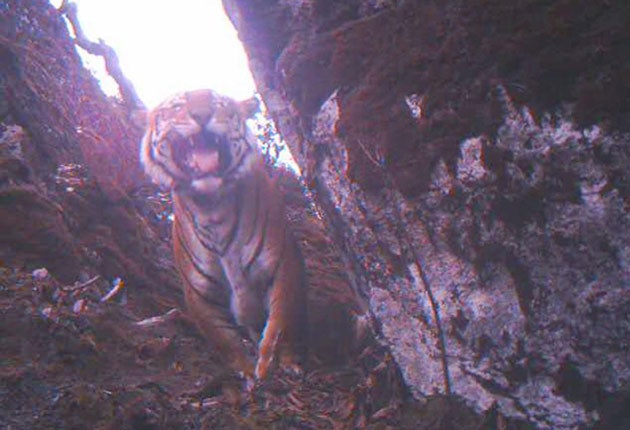BBC cameras capture rare glimpse of mountain tigers

Your support helps us to tell the story
From reproductive rights to climate change to Big Tech, The Independent is on the ground when the story is developing. Whether it's investigating the financials of Elon Musk's pro-Trump PAC or producing our latest documentary, 'The A Word', which shines a light on the American women fighting for reproductive rights, we know how important it is to parse out the facts from the messaging.
At such a critical moment in US history, we need reporters on the ground. Your donation allows us to keep sending journalists to speak to both sides of the story.
The Independent is trusted by Americans across the entire political spectrum. And unlike many other quality news outlets, we choose not to lock Americans out of our reporting and analysis with paywalls. We believe quality journalism should be available to everyone, paid for by those who can afford it.
Your support makes all the difference.A British film crew has recorded rare footage of tigers high in the mountains of Bhutan, giving hope to conservationists who plan to link Asia's shrinking populations of the big cats.
A team from the BBC's Natural History Unit spent six weeks trying to film the elusive animals. One of the cameramen, Gordon Buchanan, said he was reduced to tears by the grainy images captured by his lens. "It was beyond words [and] pretty overwhelming," he added. "The purpose of the expedition was to film evidence of tigers living in Bhutan so all the effort and everything we did came down to a few seconds of footage."
The documentary team wedged hidden cameras into gullies and trees during their expedition to the Himalayan kingdom. They filmed Bengal tigers prowling at 13,000ft above sea level, more than twice the height of Ben Nevis. Their remote existence means that the world's biggest cat, Panthera tigris, may be able to survive away from human encroachment. Tigers once roamed from Turkey to eastern Russia but their numbers have dwindled by 95 per cent since 1900 because of hunting, loss of habitats and poaching. As few as 3,000 remain in the wild and are under threat of extinction.
In an effort to create a genetically viable tiger population, the Wildlife Conservation Society and the Panthera Foundation hope to establish a 5,000-mile corridor spanning eight countries from Bhutan to Burma which would allow tigers to move freely across their largest remaining block of habitat. Bhutan has one of the smallest tiger populations, estimated at between 67 and 81 adults. Mr Buchanan said his team was convinced the tigers they saw were breeding, and that there must be cubs in the mountains that potentially gave the species a future. "I have spent time working with tigers in India and looking for them in Russia and they face problems pretty much everywhere," he added. "But Bhutan is so wild poachers would find it very difficult to hunt them there."
Alan Rabinowitz, a biologist, said: "Tigers are thought of as jungle creatures yet we now know they can live and breed at this altitude, which is a safer habitat for them. Bhutan was the missing link in this tiger corridor."
n 'Lost Land Of The Tiger' starts at 9pm on BBC1 tomorrow (except Scotland).
Join our commenting forum
Join thought-provoking conversations, follow other Independent readers and see their replies
Comments